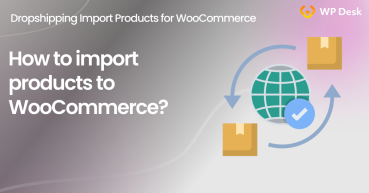Have you recently wondered how to open an online shop at a low cost and verify whether your business idea makes sense? In this post, you will learn how to do dropshipping in WooCommerce cost-free*.
*if you only know a little about WordPress and WooCommerce
The aim of this text is to describe how to validate a business idea for selling products as quickly and inexpensively as possible with help of fantastic tools that are reachable for free.
Here is the list of contents of the post:
✅ What is dropshipping?
✅ Why dropshipping is a cool selling model to start with?
✅ How to start dropshipping in WooCommerce?
✅ How could import XML = Dropshipping in WooCommerce?
✅ What after importing products to WooCommerce?
✅ Store developing tips
Contents
- What is dropshipping?
- Why dropshipping is a cool selling model to start with?
- To the point - how to start dropshipping in WooCommerce?
- How could import XML = Dropshipping in WooCommerce?
- What about after importing products to WooCommerce?
- Some store developing tips*
- Lastly...
- Dropshipping XML WooCommerce - import products to your store
- Faster WooCommerce with the bulk import of products (free plugin)
- How to start e-commerce dropshipping store without inventory using WooCommerce
- WooCommerce XML import is simple with this plugin. Just try!
- New WooCommerce XML Dropshiping plugin
Dropshipping XML WooCommerce PRO
Automatic synchronization of product imports
I want to buy it! or View DetailsWhat is dropshipping?
Since you're here, you probably know what dropshipping is. If so, please scroll down to the next headline. Because I've added an explanation below for those who don't know it yet ????
Dropshipping is selling where someone else (another company) maintains the product stock for you and ships the products to your customers. So, all work in your shop you need to do is to drive the communication of products in your store. But all the logistics - like packing, shipping are handled by your suppliers.
Why dropshipping is a cool selling model to start with?
Well, firstly, you only account for those products that you have sold. You don't have to maintain inventory, which means you don't invest before you start selling. The money is in your pocket before the shop launch.
Secondly, you don't have to worry about shipping and dealing with carriers. This is taken care of by your supplier. In some countries, if you want to pay less per parcel, you have to sign a contract with the carrier and specify how many parcels you will send per day. This is fair - the carriers want to make money out of it too. But when you start a shop, you don't send many parcels. So you pay more for one parcel. Thus, you are less competitive in the market.
The dropshipping model helps here.
Thirdly, logistics. You don't have to pack and ship, so you have more time for customer acquisition. Do your SEO a beast!
To the point - how to start dropshipping in WooCommerce?
Already have a shop? If so, let me get you to the next headline.
If you don't have a shop yet, you will first need to install the WooCommerce plugin on your WordPress site. You can find the WooCommerce plugin here →.
Its installation is the same as for any WordPress plugin. Search for it using the search engine under Plugins → Add New in the WordPress Dashboard.

After installing WooCommerce, you will be guided through the setup process using the wizard. Let it guide you through, but be careful, especially with the tax part.
From my point of view, taxes are the most important part of WooCommerce configuration. Take a look at the article about tax configuration, where my work-buddy explains the setup options.
After setting WooCommerce, install the plugin Dropshipping XML WooCommerce.
The Dropshipping XML WooCommerce plugin is used to import products from any XML or CSV files that you get from your supplier, into WooCommerce.
You will import simple and variable products with it, along with images and all key fields. This way, you can save a lot of time and import hundreds or thousands of products in minutes. Just take a look at the video, about the process of importing products using it:
How could import XML = Dropshipping in WooCommerce?
We have the add-on that allows exporting orders from WooCommerce to the suppliers on our to-do list. If you are interested in it, let me know →.
Import is surely not everything, however, the free Dropshipping XML WooCommerce plugin will automate the worst job for you - manually adding products to WooCommerce.
What's worth adding, is the PRO version of Dropshipping XML WooCommerce gives the ability to cyclically sync products in WooCommerce with a file from your supplier. You can choose the interval for synchronization and make e.g. the prices and stock always up to date with the supplier's database. So by using the PRO plugin, you can fully automate the most time-consuming tasks of running a shop.
But there's even more. Because the PRO plugin gives you the ability to be flexible in choosing what content to import, as you may set conditions to be met for products to import.
What about after importing products to WooCommerce?
If you haven't done this already, it's essential that you do.
Without this, it may turn out that all the effort you put into the following activities is pointless.
If you want to know how to build personas, or how to do simple niche market research - let me know in the comments section. It could be a nice topic for an article for me.
Products - imported or manually created - are in your store and you know the product's features are. So it's worth looking for an idea to attractively show them in the store. Start creating a store layout. Below I have added some tips that you can use when setting up your shop.
Some store developing tips*
*not only for WooCommerce stores.
These are certainly not all things worth mentioning, but let's take this as a start. If you feel something would be good to add here - again - let me know in the comments. ????
Each of these tips deserves a separate article or a whole series. I will try to ensure that, over time, links to detailed articles on tips will go here.
1. Attractiveness of landing pages
✅ Your shop should appeal primarily to your potential customers, not to you. Be flexible when it comes to your tastes. Be guided by your personas/customers!
✅ Adapt your shop design to the type of product you want to sell. Consider what content type is useful to your customers.
✅ Make sure your product images are attractive. If your supplier doesn't take good photos, it's a consideration to take them yourself, even in the first phase of your shop.
✅ Optimize site speed. Disable unused plugins and don't use high-resolution images. When choosing a theme, make sure you use all (or most) of its features.
2. Selling funnel
✅ Plug your shop into analytics tools to check the flow of users through the purchasing process. Pay attention to the abandoned step of the selling process.
✅ Use one CTA per landing page and reduce the number of "distractions" through the selling process.
✅ Test by yourself and along with users. Working with early adopters can give you lots of fantastic feedback. Also listen to shop users - if they report you a problem, find out what's the cause.
✅ Choose payment methods used and trusted in the market in which you’re selling.
3. SEO
✅ Use SEO validators for WordPress posts. Like Yoast, or All-in-One SEO.
✅ Use tools such as Ahrefs Tool Generator, or Keyword Tool to check the value of keywords.
✅ Remember that it's easier to position your site for long-tail phrases. Focus on them.
✅ Try to get links from other sites - thematic blogs, social media, price comparisons, and Google Merchant.
4. Simple communication
✅ Be reachable. Let customers know how they can contact you, and answer without delay.
✅ Simplify in-store shopping rules. Make them legal and simple.
✅ Ensure good reviews of products and your shop. Positive reviews are a great help in making a purchase decision.
✅ Let yourself be likeable. Shorten the distance and ensure good, pleasant communication.
Lastly...
I know that for beginners the amount of knowledge can be overwhelming. But the main message of this article is that with fantastic tools like Dropshipping XML, a huge amount of manual, tedious work can be automated. And you are able to validate your business ideas much faster than a few years ago. I really hope you feel this when you finish reading.
Also, I hope for your feedback. Please feel free to comment on how to improve the post to become useful for many! ✌️






